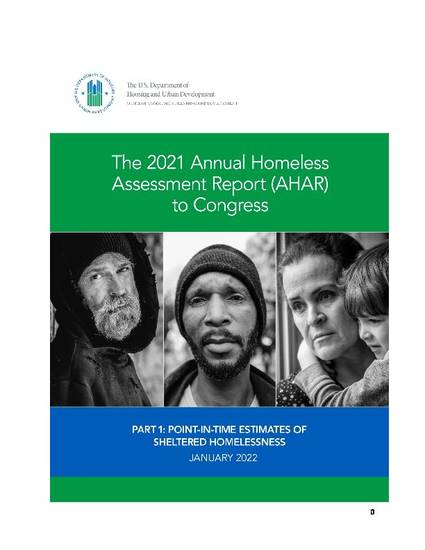
Other
The 2021 Annual Homeless Assessment Report (AHAR) to Congress, Part 1: Point-in-Time Estimates of Sheltered Homelessness
(2022)
Abstract
Because of pandemic-related disruptions to counts of unsheltered homeless people in January 2021, these findings focus on people experiencing sheltered homelessness. In response to the COVID-19 pandemic, HUD encouraged communities to determine whether conducting an unsheltered PIT count posed a high risk of exacerbating COVID-19 transmissions, given the lack of widespread access to COVID-19 vaccines at the time. Many CoCs chose to not conduct an unsheltered PIT count because their capacity to conduct counts was limited due to other pandemic-response efforts and the risk of transmitting COVID-19 among people experiencing homelessness, homeless assistance staff, and volunteers. There were 226 communities that conducted either complete or partial counts of unsheltered homelessness, but those communities are not representative of all communities across the United States.
On a single night in 2021, more than 326,000 people were experiencing sheltered homelessness in the United States. Six in ten were individuals—that is, people in households with only adults or in households with only children. Four in ten were people in families with children. The number of people staying in sheltered locations decreased by eight percent between 2020 and 2021. While this continues a decline that began in 2015, the drop between 2020 and 2021 was steeper than those in recent years. A possible cause for sheltered reduction is that some emergency shelter providers increased the amount of space between people sleeping in congregate settings to reduce their risk of exposure, leading to fewer beds in congregate shelters. Other potential factors that led to the decrease: people’s reluctance to use available shelter beds because of health risk, and eviction moratoria, and cash transfers that may have reduced inflow into homelessness. It appears that the unsheltered population did not increase within the communities that conducted unsheltered counts. However, trends on unsheltered homelessness are known for just over half of communities, which accounted for only 22 percent of unsheltered homelessness in 2020.
Keywords
- homelessness,
- United States,
- Covid
Disciplines
Publication Date
February 4, 2022
Citation Information
Meghan Henry, Tanya de Sousa, Collette Tano, Nathaniel Dick, et al.. "The 2021 Annual Homeless Assessment Report (AHAR) to Congress, Part 1: Point-in-Time Estimates of Sheltered Homelessness" (2022). Washington: US Department of Housing and Urban Development.
Available at: http://works.bepress.com/dennis_culhane/265/
